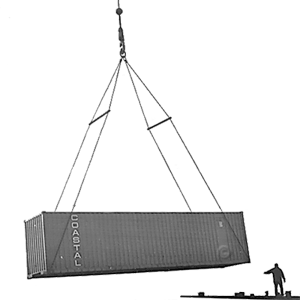Container Handling


Mishandling is by far the most serious cause of accidents and it is incumbent on lifting operators to implement 'best practice' as laid down in the International Standard ISO 3874:1997(E), Series 1 freight containers- Handling and securing. The relevant part of this document, is Allowable Lifting Methods and covers all aspects of lifting freight units stating what is "Allowed" and what is "Not Allowed" for both loaded and unloaded units, The statutary limits concerning MGW and load distribution of containers are also covered in 4.2 Packing Loading and emptying in the same document. >
Sole Distributers
UK 01384 636421 Intl. 441384 636421
Container Corner Fittings

Before the mechanics of brittle fracture were fully undestood, corner fitting impact strength requirements omitted any reference to this failure mode and many corner castings on containers carried on rail cars, failed in colder climes. Nowadays corner castings for working at low temperature of -40°C are fitted as standard.
Bottom Corner Fitting
 Side and end apertures have the same profile.
Side and end apertures have the same profile.
Top Corner Fitting

Lugs used in the side aperture only, NEVER the end.
Allowable Lifting Methods
A summary of specified lifting methods is given in ISO 3874, this replaces BS 3951:1989 previously used as the main reference when container handling. The current standard refers to the lifting of CTU's as being "Allowed" or "Not Allowed" methods of lifting and provides detailed charts for all specified lifting methods. The main methods of lifting freight units from their corner fittings are shown below.Top Lift (6.2) Spreader
 Four point vertical lift from bottom corners, side or end apertures.
Four point vertical lift from bottom corners, side or end apertures.Top Lift Sling (6.3)
 For empty or lightly loaded Units. Never when laden.
For empty or lightly loaded Units. Never when laden.Bottom Lift Sling (6.4)
 Single Point Lift. Main method for lifting fully laden CTU's. See below.
Single Point Lift. Main method for lifting fully laden CTU's. See below.End Lifting
 Not a classified method in ISO 3874 but in widespread use for Side Loaders.
Not a classified method in ISO 3874 but in widespread use for Side Loaders.Top Lift Spreader (6.2)

OOG cargo should be uniformly distributed resulting with Central of Gravity hence the load is carried equally by all 4 vertical slings.
Top Lift Sling (6.3)

Bottom Lift Sling (6.4)

Depending on both the lifting height and weight of unit being lifted some intermediate gear may be required. The example here shows a container being lifted using slings with spreaders, these are usually steel tubes strong enough to react the axial compressive force induced by slings where attached to spreader. These prevent slings making contact with container's top side edge rail with the possibility of serious damage. When handling empty or light non ISO Standard process units, spreaders are often dispensed with to minimise lifting gear requirements. Other typical sling arrangements used are shown below for various height and weight limitations, Many types of lifting gear assemblies are available off the shelf or for hire.
Typical Bottom Lift Sling arrangements
Two Leg Slings
 For empty containers or light process units. Forces at contact points on top side rails.
For empty containers or light process units. Forces at contact points on top side rails.Top Lifting Beam
 For minimum head room and limited lifting height. Substantial heavy beam is required.
For minimum head room and limited lifting height. Substantial heavy beam is required.Truss & Single Spreader
 Beam replaced by truss. Spreader under compression.
Beam replaced by truss. Spreader under compression.Two Spreaders
 Most common type, spreader forces half those for single spreader
Most common type, spreader forces half those for single spreaderLimiting Transportation Loads
 Eight axle transporter.
Eight axle transporter.
In the UK and EU the axle loading results with a maximum Gross Trailer Weight (GTW) of 48 tonne and is normally shown on a plate or sticker fitted to the vehicle.
Since the minimum weight of transporting vehicle must be 3.5 tonne the maximum possible is 44.5 tonne. In reality the payload will be less since transport vehicle may be well above the minimum quoted here.
Handling by unspecified lifting methods. (5.2).
Over the years there have been many developments in container handling, in particular, the now ubiquitus Side Lifting Machines for which there is still no reference to this lifting mode in ISO 3874. Not all freight units, fitted with ISO corner fittings resemble ISO Containers and may not even carry a In addition, the method of handling them could fall outside the remitt of the "Allowable Lifting Methods" cited above but must still comply with International Standard Practices. Once again this falls upon the auspices of a "responsible person". Who else?Now that BS 3591 is obsolete ( Withdrawn) there is greater flexibility to the interpretation of the current ISO Standard and clause 5.2 has been added to Section 6 of the current standard and applies to the lifting of both non standard freight units under exeptional operating situations.

